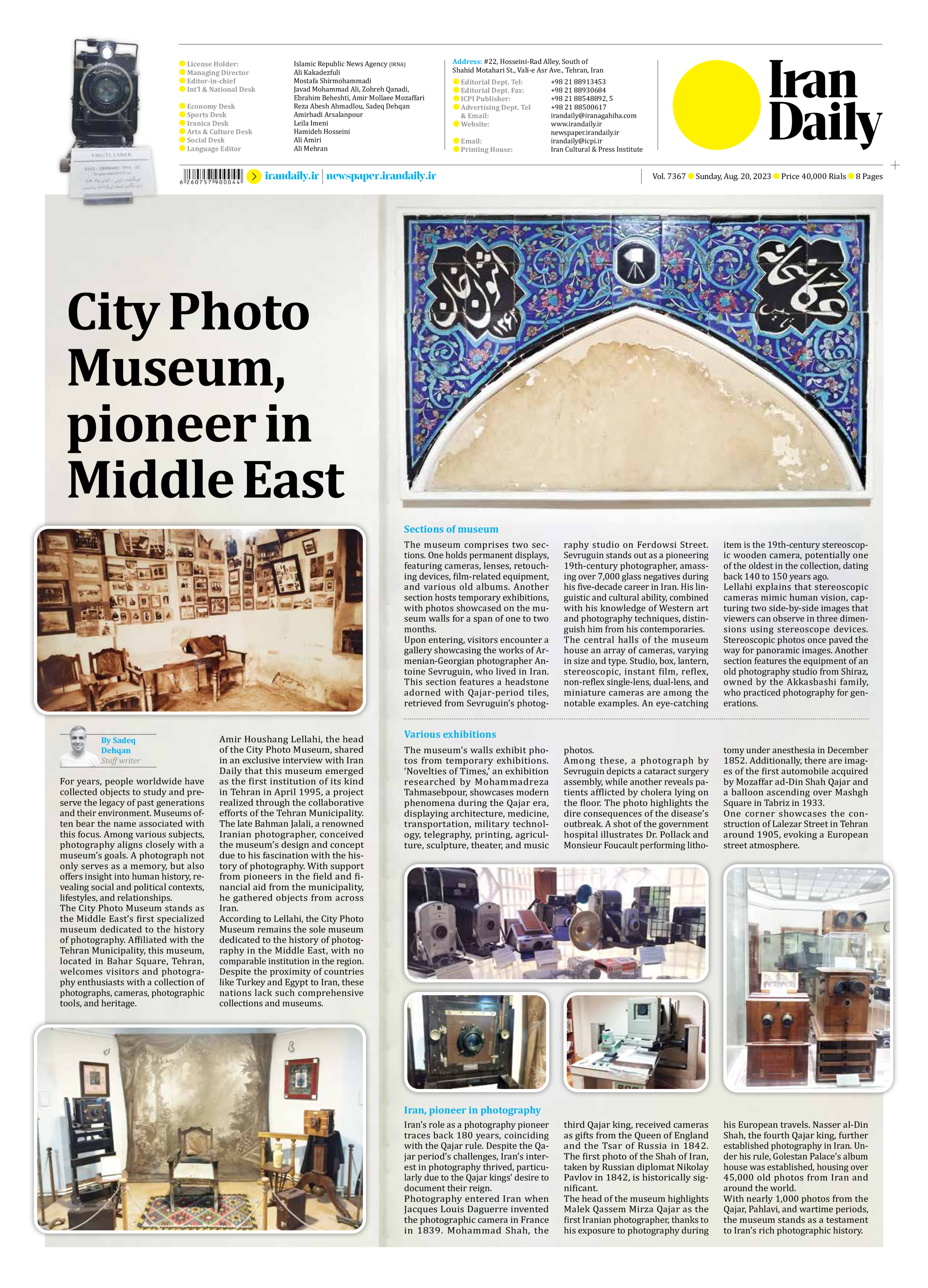
City Photo Museum, pioneer in Middle East
By Sadeq Dehqan
Staff writer
For years, people worldwide have collected objects to study and preserve the legacy of past generations and their environment. Museums often bear the name associated with this focus. Among various subjects, photography aligns closely with a museum’s goals. A photograph not only serves as a memory, but also offers insight into human history, revealing social and political contexts, lifestyles, and relationships.
The City Photo Museum stands as the Middle East’s first specialized museum dedicated to the history of photography. Affiliated with the Tehran Municipality, this museum, located in Bahar Square, Tehran, welcomes visitors and photography enthusiasts with a collection of photographs, cameras, photographic tools, and heritage.
Amir Houshang Lellahi, the head of the City Photo Museum, shared in an exclusive interview with Iran Daily that this museum emerged as the first institution of its kind in Tehran in April 1995, a project realized through the collaborative efforts of the Tehran Municipality. The late Bahman Jalali, a renowned Iranian photographer, conceived the museum’s design and concept due to his fascination with the history of photography. With support from pioneers in the field and financial aid from the municipality, he gathered objects from across Iran.
According to Lellahi, the City Photo Museum remains the sole museum dedicated to the history of photography in the Middle East, with no comparable institution in the region. Despite the proximity of countries like Turkey and Egypt to Iran, these nations lack such comprehensive collections and museums.
Sections of museum
The museum comprises two sections. One holds permanent displays, featuring cameras, lenses, retouching devices, film-related equipment, and various old albums. Another section hosts temporary exhibitions, with photos showcased on the museum walls for a span of one to two months.
Upon entering, visitors encounter a gallery showcasing the works of Armenian-Georgian photographer Antoine Sevruguin, who lived in Iran. This section features a headstone adorned with Qajar-period tiles, retrieved from Sevruguin’s photography studio on Ferdowsi Street. Sevruguin stands out as a pioneering 19th-century photographer, amassing over 7,000 glass negatives during his five-decade career in Iran. His linguistic and cultural ability, combined with his knowledge of Western art and photography techniques, distinguish him from his contemporaries.
The central halls of the museum house an array of cameras, varying in size and type. Studio, box, lantern, stereoscopic, instant film, reflex, non-reflex single-lens, dual-lens, and miniature cameras are among the notable examples. An eye-catching item is the 19th-century stereoscopic wooden camera, potentially one of the oldest in the collection, dating back 140 to 150 years ago.
Lellahi explains that stereoscopic cameras mimic human vision, capturing two side-by-side images that viewers can observe in three dimensions using stereoscope devices. Stereoscopic photos once paved the way for panoramic images. Another section features the equipment of an old photography studio from Shiraz, owned by the Akkasbashi family, who practiced photography for generations.
Various exhibitions
The museum’s walls exhibit photos from temporary exhibitions. ‘Novelties of Times,’ an exhibition researched by Mohammadreza Tahmasebpour, showcases modern phenomena during the Qajar era, displaying architecture, medicine, transportation, military technology, telegraphy, printing, agriculture, sculpture, theater, and music photos.
Among these, a photograph by Sevruguin depicts a cataract surgery assembly, while another reveals patients afflicted by cholera lying on the floor. The photo highlights the dire consequences of the disease’s outbreak. A shot of the government hospital illustrates Dr. Pollack and Monsieur Foucault performing lithotomy under anesthesia in December 1852. Additionally, there are images of the first automobile acquired by Mozaffar ad-Din Shah Qajar and a balloon ascending over Mashgh Square in Tabriz in 1933.
One corner showcases the construction of Lalezar Street in Tehran around 1905, evoking a European street atmosphere.
Iran, pioneer in photography
Iran’s role as a photography pioneer traces back 180 years, coinciding with the Qajar rule. Despite the Qajar period’s challenges, Iran’s interest in photography thrived, particularly due to the Qajar kings’ desire to document their reign.
Photography entered Iran when Jacques Louis Daguerre invented the photographic camera in France in 1839. Mohammad Shah, the third Qajar king, received cameras as gifts from the Queen of England and the Tsar of Russia in 1842. The first photo of the Shah of Iran, taken by Russian diplomat Nikolay Pavlov in 1842, is historically significant.
The head of the museum highlights Malek Qassem Mirza Qajar as the first Iranian photographer, thanks to his exposure to photography during his European travels. Nasser al-Din Shah, the fourth Qajar king, further established photography in Iran. Under his rule, Golestan Palace’s album house was established, housing over 45,000 old photos from Iran and around the world.
With nearly 1,000 photos from the Qajar, Pahlavi, and wartime periods, the museum stands as a testament to Iran’s rich photographic history.







